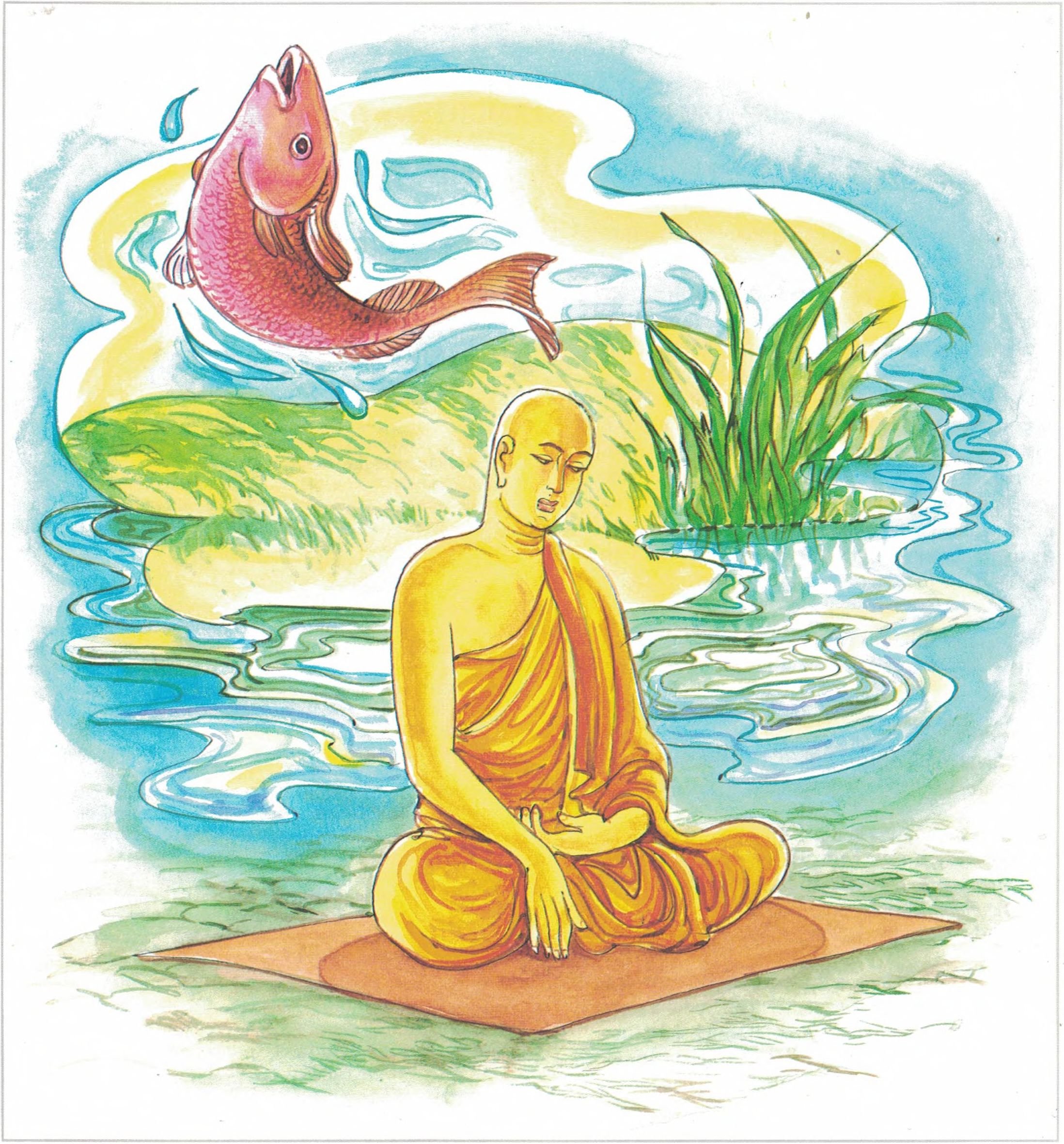Dhammapada (Illustrated)
by Ven. Weagoda Sarada Maha Thero | 1993 | 341,201 words | ISBN-10: 9810049382 | ISBN-13: 9789810049386
This page describes The Story of Venerable Meghiya which is verse 33-34 of the English translation of the Dhammapada which forms a part of the Sutta Pitaka of the Buddhist canon of literature. Presenting the fundamental basics of the Buddhist way of life, the Dhammapada is a collection of 423 stanzas. This verse 33-34 is part of the Citta Vagga (Mind) and the moral of the story is “Like the fletcher the arrow the wise one straightens the fickle mind.” (first part only).
Verse 33-34 - The Story of Venerable Meghiya
Pali text, illustration and English translation of Dhammapada verse 33-34:
phandanaṃ capalaṃ cittaṃ durakkhaṃ dunnivārayaṃ |
ujuṃ karoti medhāvī usukāro'va tejanaṃ || 33 ||
vārijo'va thale khitto okamokata ubbhato |
pariphandatidaṃ cittaṃ māradheyyaṃ pahātave || 34 ||
33. Mind agitated, wavering, hard to guard and hard to check, one of wisdom renders straight as an arrow-maker with a shaft.
34. As fish from watery home is drawn and cast upon the land, even so flounders this mind while Māra’s Realm abandoning.
 Like the fletcher the arrow the wise one straightens the fickle mind. |
 Like a fish out of its watery abode, this mind trembles at having to abandon Māra’s realm. |
The Story of Venerable Meghiya
While residing on the Cālikā Mountain, the Buddha spoke these verses, with reference to Venerable Meghiya.
Once, by reason of attachment to the three evil thoughts, lust, hatred, delusion, Venerable Meghiya was unable to practice Exertion in this mango-grove and returned to the Buddha. The Buddha said to him, “Meghiya, you committed a grievous fault. I asked you to remain, saying to you, ‘I am now alone, Meghiya. Just wait until some other monk appears.’ But despite my request, you went your way. A monk should never leave me alone and go his way when I ask him to remain. A monk should never be controlled thus by his thoughts. As for thoughts, they are flighty, and a man ought always to keep them under his own control.”
At the conclusion of the stanzas Meghiya was established in the fruit of conversion and many other monks in the fruits of the second and third paths.
Explanatory Translation (Verse 33)
phandanaṃ capalaṃ durakkhaṃ dunnivārayaṃ
cittaṃ medhāvī ujuṃ karoti usukāro tejanaṃ iva
phandanaṃ [phandana]: pulsating, throbbing; capalaṃ [capala]: fickle, unsteady; durakkhaṃ [durakkha]: difficult to guard; dunnivārayaṃ [dunnivāraya]: hard to restrain; cittaṃ [citta]: the mind; medhāvī: the wise one; ujuṃ karoti: straightens; usukāro iva: like a fletcher; tejanaṃ [tejana]: an arrow-shaft
In the Dhammapada there are several references to the craftsmanship of the fletcher. The Buddha seems to have observed the process through which a fletcher transforms an ordinary stick into an efficient arrow-shaft. The disciplining of the mind is seen as being a parallel process. In this stanza the Buddha says that the wise one straightens and steadies the vacillating mind that is difficult to guard, like a fletcher straightening an arrow-shaft.
Explanatory Translation (Verse 34)
okamokata ubbhato thale khitto vārijo iva idaṃ
cittaṃ pariphandati māradheyyaṃ pahātave
okamokata: from its watery abode; ubbhato [ubbhata]: taken out; thale: on dry land; khitto [khitta]: thrown; vārijo iva: like a fish; idaṃ cittaṃ [citta]: this mind; pariphandati: trembles; māradheyyaṃ [māradheyya]: death’s realm; pahātave: to abandon; pariphandati: flutters and trembles
When making an effort to abandon the realm of Māra (evil), the mind begins to quiver like a fish taken out of the water and thrown on land.
Commentary and exegetical material (Verse 33-34)
cittaṃ: This term is commonly translated as mind or consciousness and seen as the essence of the so-called being which plays the most important part in the complex machinery of man. It is more appropriately translated as a ‘mental state’ or, even better, an ‘emotional state’. It is this citta that is either defiled or purified, and is the bitterest enemy and the greatest friend of oneself. This citta seems to be the equivalent of ‘soul’ in Western thought. In Buddhism, however, the ‘soul’ as a permanent entity is not recognized. Citta which takes its place refers to the emotional state of a person which is not an entity but a fluctuating activity like a flame. Sometimes emotions are excited and sometimes the citta is calm (emotions are absent). We might even translate it as the ‘temperament’ or ‘temper’. Writers on Buddhism mistakenly call it ‘mind’ or ‘consciousness’. But what is meant is the ‘affective’ rather than the cognitive aspects of the mental process. When a person is fast asleep and is in a dreamless state, he experiences a kind of mental state which is more or less passive than active. It is similar to the mental state one experiences at the moment of conception and at the moment of death. The Buddhist philosophical term for this type of mental state is Bhavanga citta which means the mental state natural to one’s condition of existence. Arising and perishing every moment, it flows on like a stream not remaining the same for two consecutive moments. We do experience this type of mental state not only in a dreamless state but also in our waking state. In the course of our life we experience Bhavanga mental states more than any other type of mental state. Hence Bhavanga becomes the natural state of mind.
Some scholars identify Bhavanga with sub-consciousness. According to the Dictionary of Philosophy sub-consciousness is ‘a compartment of the mind alleged by certain psychologists and philosophers to exist below the threshold of consciousness.’ In the opinion of some Western psychologists, sub-consciousness and consciousness co-exist.
But Bhavanga is not a sub-plane. It does not correspond to F. W. Myer’s subliminal consciousness either.
Bhavanga is so called because it is the resting state of mind that is natural to an individual’s life-continuum. That is why life-continuum has been suggested as the English equivalent for Bhavanga. But a better translation could be ‘Resting mental state’.
This Bhavanga state of mind which one always experiences as long as it is uninterrupted by external stimuli, vibrates for a thought-moment and passes away when a stimulus activates the senses. Suppose, for instance, the eye is stimulated. Then the Bhavanga stream of consciousness is arrested and sense-door consciousness (whose function is to turn the attention towards the object) arises and passes away. Immediately after this, there arises a visual perception which sees the object, but yet knows no more about it. This sense operation is followed by a moment of the reception of the object so seen. Next arises the investigating thought-moment which momentarily examines the object so seen. This is followed by the determining thought-moment. On this depends the subsequent psychologically important stage Javana. It is at this stage that an action is judged, whether it be moral or immoral when discrimination is exercised and will play its part. Kamma is performed at this stage.
If decided correctly, it becomes moral; if wrongly, immoral. Irrespective of the desirability or the undesirability of the object presented to the mind, it is possible for one to make the Javana process moral or immoral. If, for instance, one meets an enemy, anger will arise automatically. A wise person might, on the contrary, with self-control, radiate a thought of love towards him.
This is the reason why the Buddha stated:
By self is evil done,
By self is one defiled,
By self is no evil done,
By self is one purified.
Both defilement and purity depend on oneself.
No one is purified by another.
It is an admitted fact that environment, circumstances, habitual tendencies and the like condition our thoughts. On such occasions will is subordinated. There exists however the possibility for us to overcome those external forces and produce moral and immoral thoughts exercising our own free will. An extraneous element may be a causative factor, but we ourselves are directly responsible for the actions that finally follow.
It is extremely difficult to suggest a suitable rendering for Javana.
A perception is suggested by some. Impulse is suggested as an alternative rendering, which seems to be less satisfactory than a perception. Here, the Pāli term is retained.
Javana, literally, means running. It is so called because, in the course of a thought-process, it runs consequently for seven thought-moments, or, at times of death, for five thought-moments with an identical object. The mental states occurring in all these thought-moments are similar, but the potential force differs.
This entire thought-process which takes place in an infinitesimal part of time ends with the registering consciousness lasting for two thought-moments. Thus one thought-process is completed at the expiration of seventeen thought-moments. This is the analysis of a thought process involved in the experience of an object,
In the Buddhist system an essential element in the quest for higher spiritual achievement is the reflection upon the real nature of the mind–cittānupassanā.
‘Cittānupassanā’ means reflection of mind. The mind is so complex and subtle that even modern science has not been able to grasp its real nature. But the Buddha was able to comprehend the real nature of the mind by developing his own mind. Development of mind leads to concentration. The mind thus developed could be easily diverted to transcendental knowledge. However, such a state cannot be attained easily. The mind does not rest in one object, it always strays away. When one attempts to control the mind, it wriggles like a fish taken out of water. Therefore the controlling of the mind should be done with great effort.
According to the Abhidhamma there are 121 types of the mind. In this meditation (Cittānupassanā) 16 aspects of the mind are described. They are:
